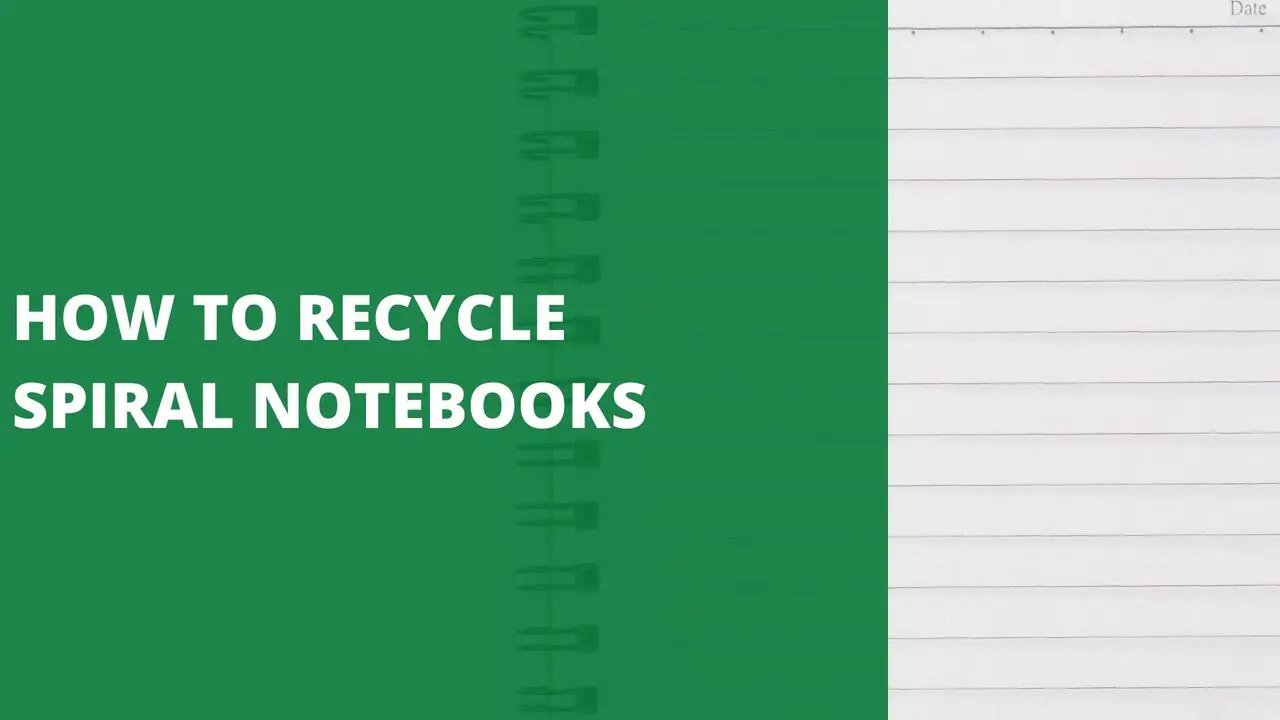Ever looked at a pile of old spiral notebooks and wondered what to do with them? Many notebooks end up in landfills each year, but there’s a bright side. Nearly every part of a spiral notebook can be recycled or repurposed. The paper pages, the cardboard cover, and even the metal or plastic bindings can get a new life.
With a few simple steps, you can sort your notebooks for recycling or find creative ways to upcycle them. Let’s explore these simple steps below in the article and learn how to make a positive impact on our environment !
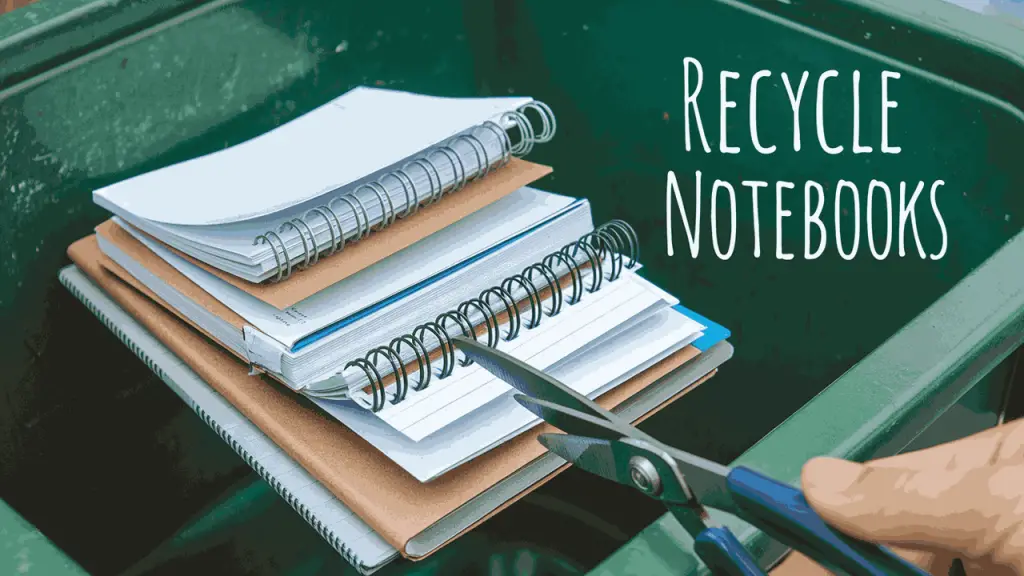
Understanding Your Spiral Notebook Components
A. Identifying materials: paper, coils, covers
To effectively recycle spiral notebooks, you need to identify their components. Your notebook typically consists of paper pages, a spiral binding (either metal or plastic), and covers (which can be plastic or cardboard). Understanding these materials is crucial for proper recycling.
B. Determining recyclability of each component
| Component | Recyclability |
| Paper | Recyclable |
| Metal coil | Recyclable |
| Plastic coil | Check local guidelines |
| Cardboard cover | Recyclable with paper |
| Plastic cover | Check local guidelines |
Preparing Your Notebook for Recycling
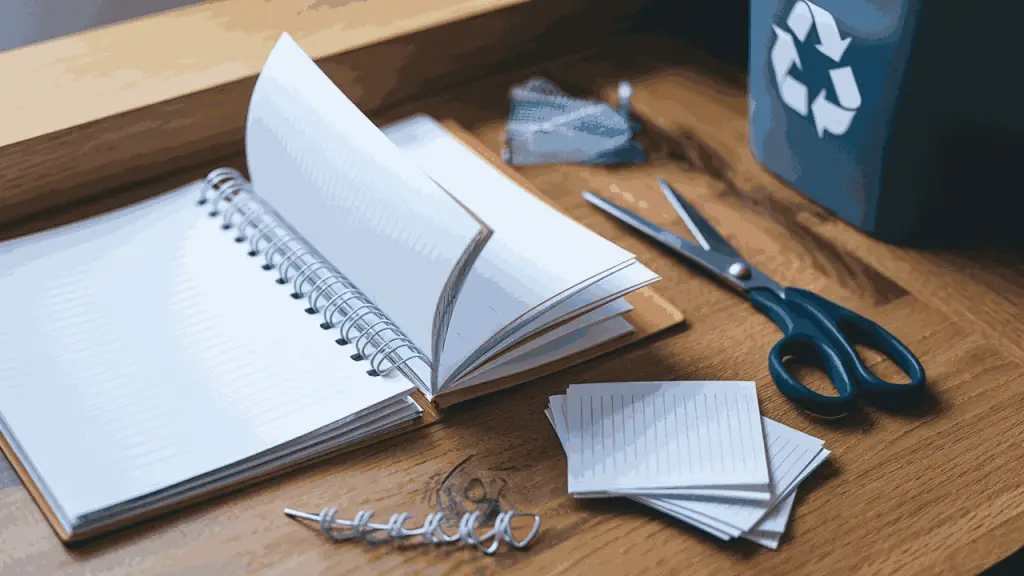
Now that we’ve understood the components of your spiral notebook, let’s prepare it for recycling.
A. Removing plastic covers and checking recycling instructions
Remove any plastic covers from your notebook and check for recycling instructions. These covers may need to be recycled separately or discarded, depending on your local guidelines.
B. Eliminating staples, clips, and stickers from paper
You’ll need to remove all staples, clips, and stickers from the paper to avoid contamination in recycling bins. This ensures a smooth recycling process.
C. Checking coil type: metal vs. plastic
| Coil Type | Recycling Method |
| Metal | Recycle separately |
| Plastic | Check local guidelines |
Identify whether your notebook has a metal or plastic coil. Metal coils can typically be recycled separately, while plastic coils may require special handling. Check with your local recycling center for specific instructions.
With your notebook properly prepared, we’ll next explore how to recycle the paper and cardboard components.
Recycling Paper and Cardboard Components
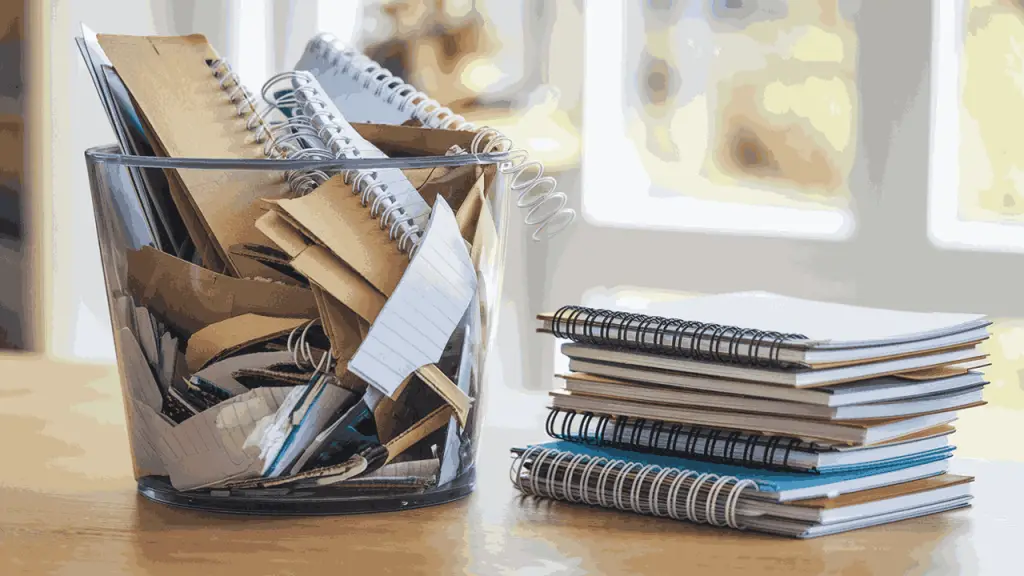
A. Guidelines for recycling notebook paper
You can recycle most of your notebook paper, including pages with colored ink. However, be aware that some restrictions apply:
- Check your local recycling guidelines, as requirements may vary by region
- Remove any plastic or metal components before recycling
- Ensure the paper is clean and free from contaminants
| Paper Type | Recyclable? |
| White paper | Yes |
| Colored ink | Yes |
| Dark-colored paper | No |
B. Handling colored or dark-colored paper
While paper with colored ink is generally recyclable, dark-colored paper poses a challenge:
- Dark-colored paper can contaminate the recycling process
- Avoid recycling pages that are entirely dark or heavily pigmented
- Consider alternative uses for dark-colored pages, such as:
- Craft projects
- Composting (if using environmentally friendly inks)
- Upcycling into new notebooks
C. Recycling cardboard covers alongside paper
You can often recycle cardboard covers along with the paper, but keep these points in mind:
- Remove any plastic coating or lamination from the covers
- Check if your local recycling facility accepts mixed paper and cardboard
- If separate recycling is required, sort the cardboard covers from the paper pages
With the paper and cardboard components sorted, you’re now ready to tackle the spiral bindings. In the next section, we’ll explore how to deal with these metal or plastic coils effectively, ensuring a comprehensive approach to recycling your spiral notebooks.
And if you’ve got old magazines piling up too, check out our guide on How to Recycle Book Magazines for more ways to keep paper products out of landfills!
Dealing with Spiral Bindings
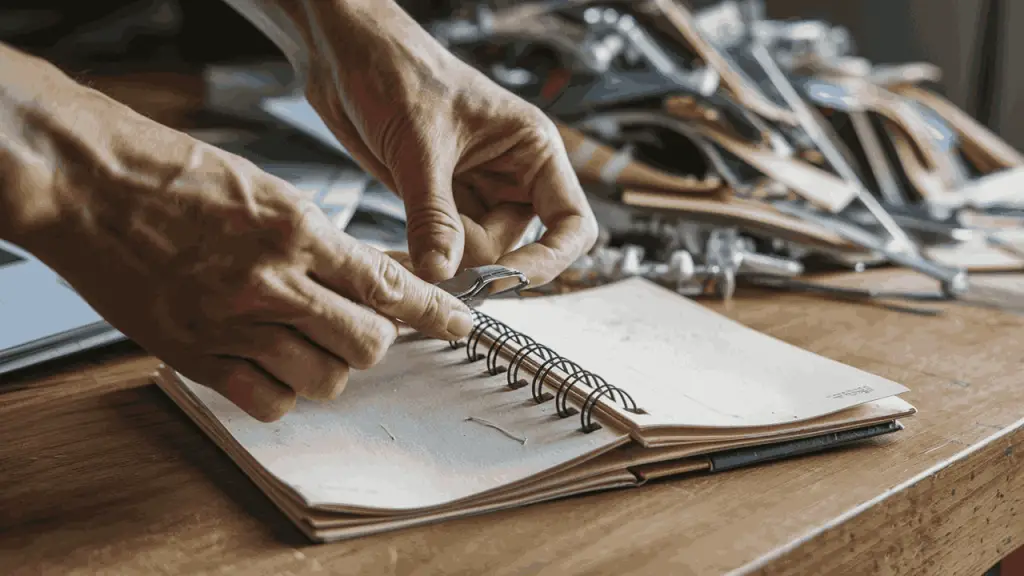
A. Methods for removing coils: spiral and individual ring
To properly recycle your spiral notebook, you’ll need to remove the binding first. Here are two common methods:
- Spiral coils:
- Gently pull the end of the coil to unwind it
- Use pliers if the coil is stubborn
- Individual rings:
- Open each ring carefully
Remove pages one by one
- Open each ring carefully
B. Recycling metal coils
Once you’ve removed the metal coils, you have several options:
- Check with your local recycling center for specific guidelines
- Place them in your metal recycling bin (if allowed)
- Consider upcycling ideas:
- Make hooks
- Create homemade paper clips
- Donate to schools or copy centers for reuse
C. Recycling plastic coils
Plastic coils require different handling:
| Plastic Coil Type | Recycling Method |
| PVC | Not recyclable, dispose in regular trash |
| Other plastics | Check local recycling guidelines |
Remember to:
- Identify the type of plastic
- Separate from paper components
- Clean the coils before recycling
Alternative Uses for Notebook Components
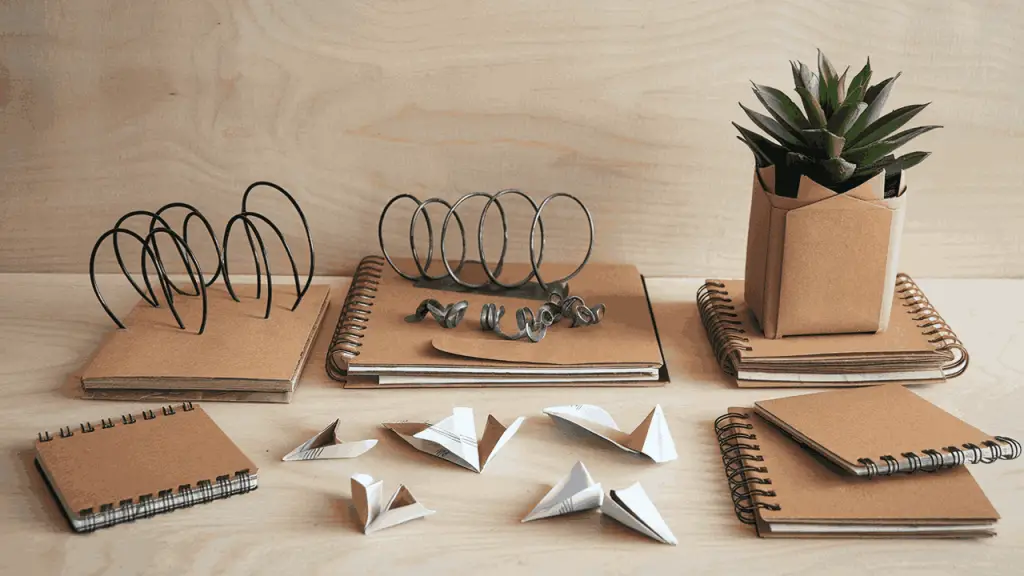
Now that we’ve covered how to deal with spiral bindings, let’s explore alternative uses for notebook components. You can give your old notebooks a new life through creative upcycling and recycling.
A. Upcycling coils into useful items
You can repurpose metal spirals into various practical items:
- Wind chimes
- Flower sculptures
- Jewelry
- Cable organizers
- Plant supports
B. Donating coils to schools or copy centers
Your local schools or copy centers might appreciate donated coils for reuse in their projects or binding services.
C. DIY options for creating notebooks from recycled materials
| Material | DIY Notebook Idea |
| Paper covers | Scrapbooking pages |
| Metal spirals | Decorative elements |
| Plastic parts | Craft components |
With these alternatives in mind, next, we’ll explore local recycling considerations to ensure proper disposal of any remaining notebook components.
Local Recycling Considerations
You should check with your area’s recycling centers for specific instructions, as rules can vary regionally. Smaller facilities may require you to remove bindings before recycling. Here’s a quick guide:
A. Checking with local recycling centers for specific guidelines
- Call or visit their website for up-to-date information
- Ask about acceptable materials and preparation steps
Also, you can visit websites like Earth911 as they have tools that help you find recycling centers near you and what stuff they take.B. Regional differences in recycling rules
| Region | Common Requirements |
| Urban | Separate components |
| Rural | Remove all bindings |
C. Importance of removing bindings for smaller recycling centers
You’ll often need to detach spiral bindings, as many smaller centers lack equipment to separate these during sorting. This simple step ensures your notebooks contribute to recycling efforts rather than ending up in landfills.
If your local recycling center doesn’t take spiral notebooks, TerraCycle’s Zero Waste Box program is a great alternative. You can mail them your notebooks, and they’ll recycle every part for you. It’s simple and perfect when local options fall short.
Embracing Sustainable Practices
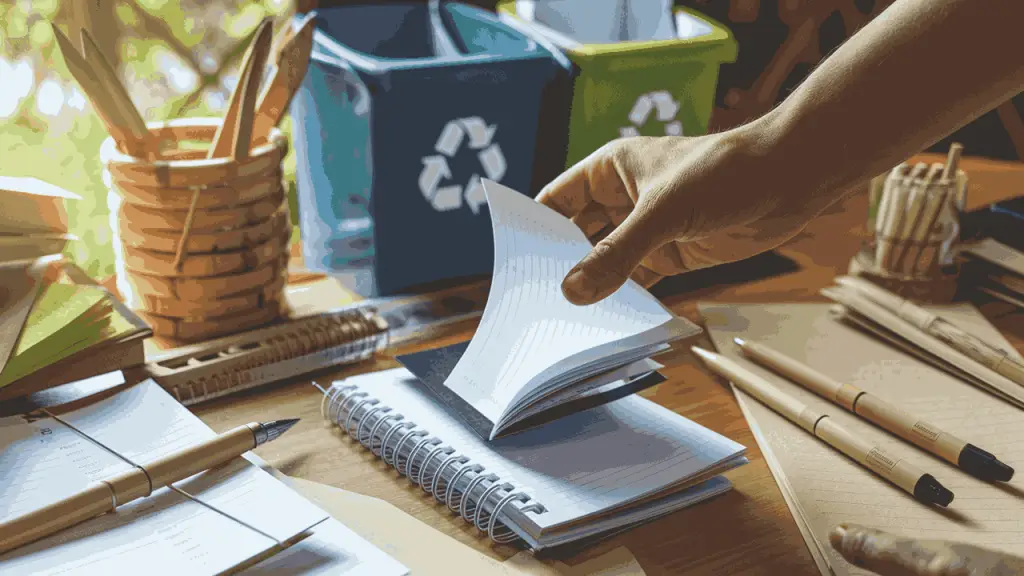
Now that we’ve explored local recycling considerations, let’s shift our focus to embracing sustainable practices for a greener future.
A. Shifting towards paperless alternatives
You can significantly reduce your environmental impact by transitioning to digital note-taking. Consider using apps like Rocketbook’s Everlast series, which allows for endless reuse. This eco-friendly option helps minimize paper waste and supports forest conservation efforts.
B. Benefits of digital note-taking
Digital note-taking offers several advantages:
- Reduces paper consumption
- Saves storage space
- Easy searchability
- Syncing across devices
- Environmentally friendly
| Traditional Notebooks | Digital Note-taking |
| Limited space | Unlimited storage |
| Physical clutter | Organized digitally |
| Manual searching | Quick search feature |
Conclusion
Recycling spiral notebooks might seem like a tiny gesture, but it really adds up in reducing waste and caring for our planet. When you take the time to separate the paper, covers, and bindings, you’re making sure each part finds its proper recycling home. Just remember to peel off any plastic covers, remove staples and stickers, and follow your local recycling guidelines.
And if you’re looking for even more ways to be eco-friendly, why not try going paperless or choosing notebooks made from recycled materials? Every bit of effort can make a real difference. So next time you’re finished with a notebook, take a moment to recycle it properly and know you’re doing your part to help the Earth.

